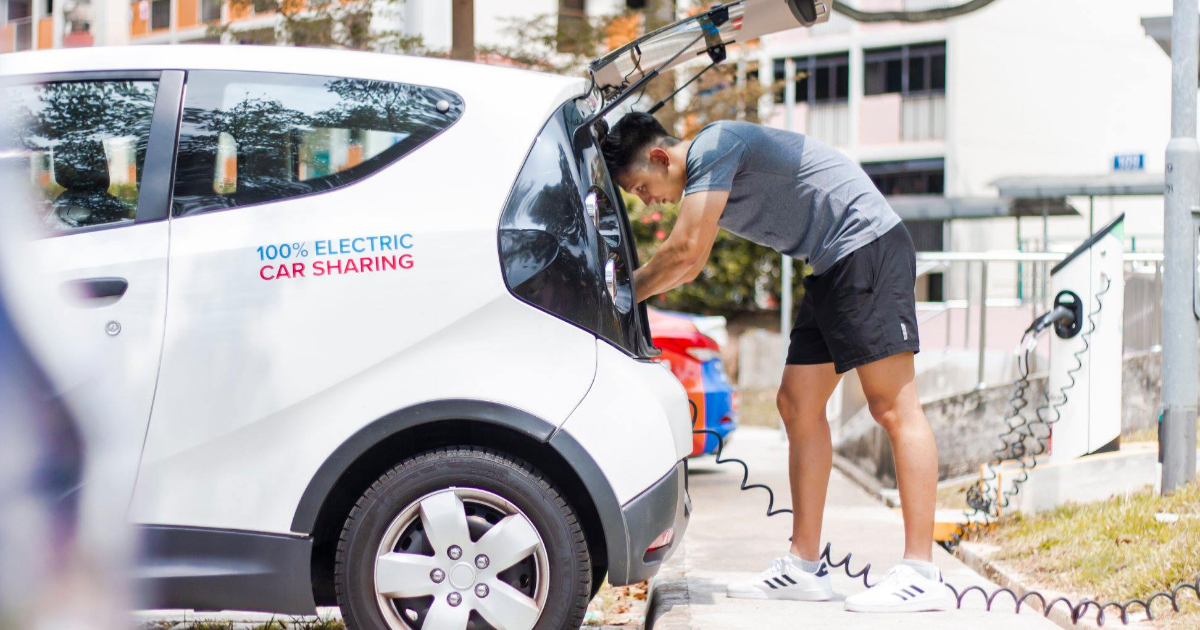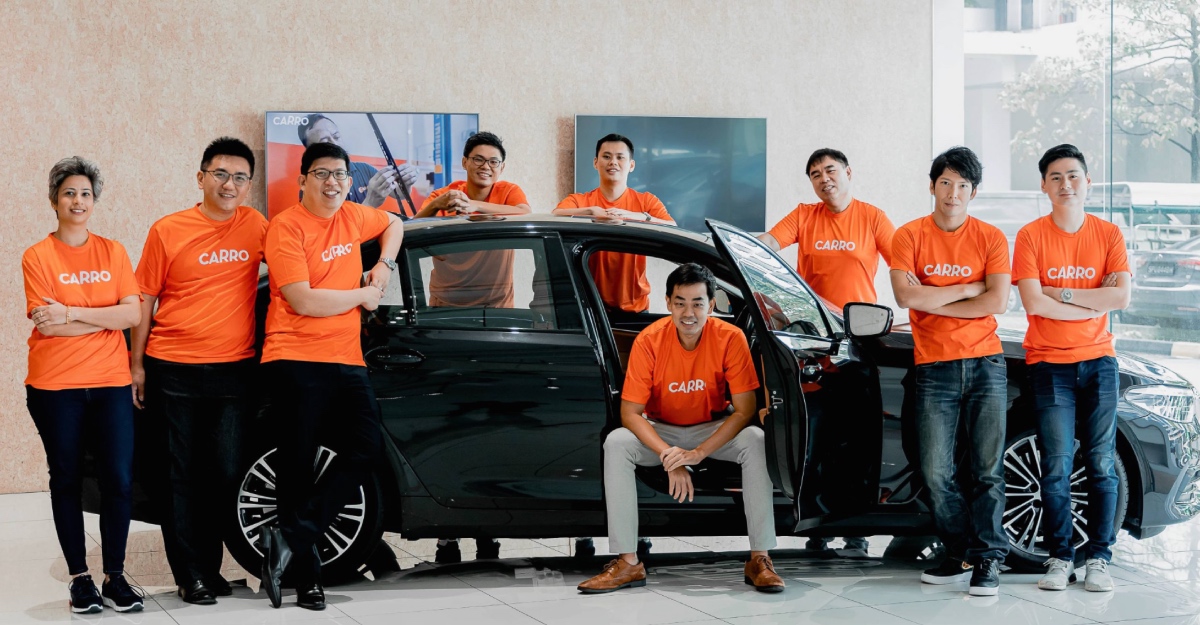Singapore aims to phase out petrol, or internal combustion engine (ICE), vehicles by 2040.
As part of the Land Transport Authority’s pilot programme on a national-level electric vehicle (EV) Car Sharing initiative, electric-car sharing service BlueSG was launched in 2017.
BlueSG, a subsidiary of Bolloré Group, will install 2,000 BlueSG charging points at 500 locations by the end of this year.
The government’s dual objective is to reduce the number of private cars on the road and propose an alternative model of transportation for its citizens, in addition to public transportation.
To scale up into a nationwide electric mobility ecosystem, Singapore has also pushed forward with shared electric scooters, electric taxis, and even driverless electric buses, a common sight in some parts of the city.
With that, we take a look at how the electric car initiative in Singapore has been faring.
The Electric Car Landscape In Singapore
Singapore ticks all the boxes for electric car sellers and drivers with its compact size, tidy roads, technology expertise, and sustainable transport ambitions.
In December 2017, BlueSG launched with 80 vehicles and 32 stations. The car sharing programme generated an immediate interest from the public with 2,000 members registering for the service before the launch.
Last December, they also launched two new subscription plans and according to BlueSG, the plans “have been successful”. In the same month last year, they also added more charging points to its network, bringing the number to 239.
Now, the numbers stand at 345 charging stations with 1,371 charging points islandwide in public housing estates, industrial buildings, shopping malls, Changi Airport, Sentosa and the city centre.
On Monday (10 August), BlueSG announced that it has hit one million vehicle rentals despite a drop in membership and rentals during the circuit breaker period.

BlueSG now has around 80,000 subscribers paying from S$8 a month.
Currently, its fleet of cars has grown to 667 and they are rented about 100,000 times a month with 4,000 subscriptions added every month.
Despite BlueSG’s strong growth, another car-sharing service Smove has exited the Singapore market and gone under liquidation.
When Smove first launched in Singapore in 2013, it only had a small fleet of six electric cars covering a small area islandwide.
Smove started off with electric vehicles, but it had to forcibly scrap this idea due to Singapore’s inadequate EV infrastructure.
Inadequate EV Infrastructure In Singapore
Senior Minister of State for Transport Janil Puthucheary said the first step to reach the 2040 goal of phasing out petrol vehicles was to ensure enough charging infrastructure for EV owners.
BlueSG is well on their way to complete setting up 500 charging locations in Singapore by the end of 2020.

Shell, which acquired EV infrastructure company Greenlots, rolled out 10 EV chargers in selected stations across Singapore. These chargers leverage the strategic locations of Shell’s 57 fuelling stations.
SP Group aims to install 1,000 EV charging points by 2020, which includes 250 direct charging points with a 50 kilowatt power rating that can fully charge an EV within 30 minutes.

Previously, most points use alternating current, and a lower 7.4kw rating, which takes the car about seven times longer to be fully charged.
But the question is, are these charging points enough?
If you would like to charge your rented electric car from BlueSG, you have to also make sure there is a parking slot at the charging point — you can either check the availability online or reserve a space in advance.
There are quite a few charging points in central areas like Orchard, Bugis and Chinatown, although you will have to be prepared to walk to get to them. It will be much harder in suburban areas like Siglap, but at least it’s improving.
I did a search to locate a BlueSG charging point in my vicinity. The nearest one is 1.39km away (a mere four minutes walk away) and there are three parking slots available. However, there is no available charging point at the time of writing.

If you have to walk 3km to and from charging points, that is equivalent to taking a feeder bus to the MRT station.
Unless you live near a charging point, you will still need to take a Grab or public transport to get home.

Upon returning the EV, you are not able to park it illegally if there is no available parking slot, as it needs to be plugged into a charging station before you stop paying for it.
“This will not be easy, but is very important. If you are considering an EV over an ICE vehicle you must be convinced that access to a charger will be as convenient as access to a petrol station,” said Dr Janil.
Others Factors That Deter EV Adoption
Moreover, if you would prefer to own your own electric car, they cost between S$100,000 and S$160,000 for mass market models.
Higher-end models may cost up to S$500,000, but at that price range, you may well look at petroleum supercars instead.
There is also “range anxiety” — the fear that an EV will run out of charge mid-journey — which discourages private EV ownership.
EV owners tend to install their own charging points if they live in landed properties. However, most Singaporeans do not live in houses with garages where they can plug in their cars overnight.
If they live in a condominium estate, they have to get their condominium management to set up charging stations.

Authorities will also have to carefully plan where to locate EV chargers, because limitations in electricity supply could be a constraint.
This conundrum possibly highlights the question of whether the nation’s electricity grid can cope when thousands of drivers charge their cars at the same time each evening.
By September 2019, there were only 1,036 fully electric cars on the road, up from just 12 EVs in 2016, according to the Land Transport Authority. This accounts for only 0.1 per cent of the total vehicle population.
Furthermore, there has been uncertainty around standards for fast-charging infrastructure and battery technology and Singapore has been careful in adopting them.
During the Ministry of Transport’s (MOT) committee of supply debate on 5 March, Dr Janil said that the fast-charging system they will allow is called Chademo, which is adopted primarily by Japanese electric vehicle manufacturers.
However, Chademo will only be included as an optional public charging standard so it will not be mandatory for charging service operators to provide Chademo chargers at public charging stations.
As such, operators are still only required to provide Type 2 AC (slow charging) and/or Combo 2 DC (fast charging) chargers.

A Nissan Leaf Electric Vehicle’s charging time using a 6.6kW Alternating Current (AC) charger is eight hours.
We will need more of direct-current charging points with a 50 kW power rating that can fully charge an EV within 30 minutes.
Taking Heed From The Global EV Transformation
Globally, 15 member governments from Africa, Asia, Europe, and North America have adopted the Electric Vehicles Initiative (EVI), a multi-government policy forum dedicated to accelerating the introduction and adoption of electric vehicles worldwide.
EVI is one of several initiatives launched in 2010 under the Clean Energy Ministerial, a dialogue among energy ministers from the world’s major economies. EVI also sees participation from the International Energy Agency (IEA).
According to a report on Global EV Outlook, one of the major hurdles to EV adoption is the battery costs. Over US$8.7 billion pumped into research, development, and demonstration (RD&D) since 2008 have reduced battery costs significantly.
As a result, battery costs have decreased from US$1,000 kWh in 2008 to USD$485 kWh in 2012.
Aside from that, new car models from a variety of manufacturers will help to grow the EV market.
Governments are assisting in this market transformation by providing sizeable investments in research and development as well as consumer incentives.
Are Electric Cars Here To Stay?
Range anxiety shouldn’t deter Singaporeans from driving EVs as Singaporeans drive an average of 55km a day. In contrast, EVs have a range of between 250 and 300 km on a single charge.
A well-distributed and accessible charging infrastructure, especially with direct-current fast-charging, will further allay EV owners concerns.
Moreover, the Singapore government is stepping in to increase the adoption rate.
Deputy Prime Minister and Minister of Finance Heng Swee Keat announced in the Singapore Budget 2020 a few measures to encourage more Singaporeans to adopt electric cars.
Firstly, Singapore will expand the electronic vehicle charging infrastructure significantly from 1,600 charging points now to 28,000 by 2030.
With this ambitious goal, it quelled my concerns about whether we would have limitations in electricity supply since Singapore has always been at the forefront of it. In fact, we are blessed with lots of power – with a power generation sector at an overcapacity since 2015.
Secondly, the Vehicular Emissions Scheme, which metes out tax rebates and surcharges based on a vehicle’s emission levels, will be extended to light commercial vehicles.
Thirdly, an early-adoption incentive scheme will be rolled out for EV buyers from 2021 to 2023. It will offer rebates capped at S$20,000 per vehicle.
Fourthly, the road tax for EVs and some hybrids will be revised to be less punitive.
Previously, CEO of EV giant Tesla Elon Musk was quoted saying that the Singapore government has been “unwelcome” to the company, doubling down on his previous assertions that the government is not supportive of electric vehicles.

However, in the last couple of months, they have been hiring for positions in Singapore, sparking rumours that they may be setting up an office in Singapore.
Upon seeing the good response towards BlueSG, Singapore may be more receptive towards Tesla. There’s a chance that if/when Tesla enters the Singapore market, electric cars may be much more adopted here.
Even if Singaporeans want other options besides a Tesla or a Nissan Leaf, automotive brands are pushing out their own versions of the electric car.
During the Singapore Motor Show 2020, more than 10 major brands showcased their EVs, with many more expected to launch next year.
The key attraction with fully electric cars is that they are an environmentally friendlier alternative to petroleum cars. EVs record lower emissions of harmful pollutive gases like carbon monoxide and nitrogen oxide, and greenhouse gases like carbon dioxide.
They are also touted a smoother and quieter ride, with lower running costs, and a more direct power transfer. These make EVs a compelling sell, especially to those living in densely-populated areas.
Featured Image Credit: BlueSG








